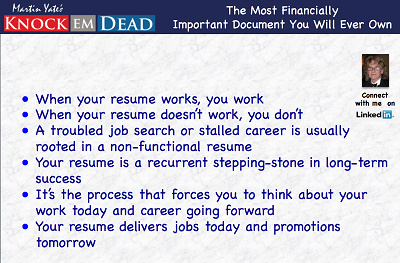
This week’s Career Q&A has tips on overcoming the fear of public speaking. Best-selling author Martin Yate, a career coach and former HR professional, takes your questions each week about how to further your career in HR. Contact him at the e-mail address at the end of this column.
I work in HR personnel, but I’m an introvert. How do I survive as an introverted HR person? I have to believe that extroverted HR professionals have a higher chance of surviving in this profession than the introverts. I am shy and do not like giving presentations, as I become very nervous when presenting before people. As a result, I work better behind the scenes. How do I overcome this? Do you think I have any chance of advancing my career?
Asikhia, Lagos, Nigeria
Your ability to communicate effectively in a group setting certainly is a key attribute in HR, as it is in any profession, because it gives you exposure to a larger professional audience and can help establish credibility and build your brand.
Audiences assimilate information by what they hear, what they see, what they read and what they write. Remembering this when you prepare a presentation will help you organize what you are going to say and provide you with “cheat sheets” to keep yourself on track.
Many studies have shown that public speaking is one of our greatest fears in life and is perhaps one of the reasons why Toastmasters International, the public-speaking training association, is so widely respected. Joining your local chapter of Toastmasters International (they have a chapter in Lagos) will help you make professional connections with people who, like you, are striving to turn their weakness into a strength.
Don’t think for a moment that you are the only one with stage fright. Public speaking makes many people’s mouths go dry and minds go blank; nearly everyone suffers from some degree of this, including me, and I’ve been doing it for more than 30 years. What you need is a personal prompter for everything you are going to say, while giving your audience something to look at and something to read while listening to you, thus delivering an enriched learning experience. As many professionals know, having a PowerPoint presentation to lean on is a lifesaver for anyone who wants to enrich their talk with visuals, and it’s easy to use.
Once you create a slide for each topic of your presentation, putting the important points you want to cover on each slide, you give your audience something to see and take notes from, while giving yourself an effective prompter that is hidden in plain sight. You can then move from slide to slide and use the bullet points on the slides to keep yourself on track, while the audience believes it is all for their benefit.
Here is a PowerPoint slide I use in resume presentations. Each bullet represents a topic, so I never lose my place while keeping the audience engaged by teasing them with a series of engaging headlines.

People also learn from what they write down. PowerPoint gives you the option to print out a very professional notebook that has each of your slides displayed on a page and followed with room for the recipient to take notes. Not only does this help the listener retain information, you can carry a copy around yourself and openly refer to it, “If you turn to page 3, you’ll see that next we are going to talk about … ”
Presenters who stand behind podiums lose their audiences to boredom. But you can move around the room as you talk, pointing at the screen. The audience stays more engaged because they follow you with their eyes and are fascinated because you are so relaxed. You also can engage your audience in the presentation by asking, “Could someone read the next bullet for us? Patricia?” That makes sure everyone pays attention.
As speakers, we are always nervous, and we try to cover it up by being formal and using bigger words than necessary, then can forget where we are and repeat ourselves. These are all mistakes that can be avoided by using smaller, everyday words and speaking casually. Rehearse your presentation to make your points more conversational, and practice with a spouse, colleague or friend.
There is so much more to be said on this topic, but this is a good start.
You can learn more about presentations in my book Knock ’Em Dead – Professional Communication.
Have a question for Martin about advancing or managing your career? From big issues to small, please feel free to e-mail your queries to YourCareerQA@shrm.org. We’ll only publish your first name and city, unless you prefer to remain anonymous—just let us know. We look forward to hearing from you!
An organization run by AI is not a futuristic concept. Such technology is already a part of many workplaces and will continue to shape the labor market and HR. Here's how employers and employees can successfully manage generative AI and other AI-powered systems.



